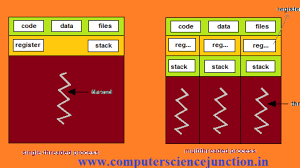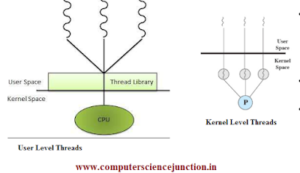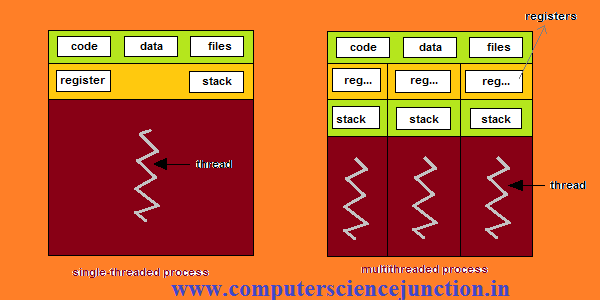Table of Contents
Threads in Operating System
Threads in operating system play an important role in improving the overall performance. There are several benefits of using the threads. These benefits are discussed in this tutorial.
Multithreading is an important concept used by most of the operating system. Computer science students should have knowledge about threads and multithreading. Questions on multithreading are generally asked many time in interview or also in GATE(CS/IT) examination.
In this threads in operating system based tutorial we will learns about several concepts of threads and multithreading environment. tem will discuss about threading concepts such as threads basic , its advantages, threads implementation in operating system , user level and kernel level threads.
Frequently Asked Questions
By the end of this tutorial students got the answer of the following questions
- What is thread in os?
- Write difference between process and thread?
- What do you understand by thread control block?
- What is program counter?
- Different benefits of using thread.
- Define multithreading.
- What is User level thread?
- What is kernel level thread?
- Difference between kernel level and user level thread.
- Benefits of user level and kernel level thread.
What is Thread in OS ?
A thread is a light weight process which can utilize the CPU independently. A thread meaning is just a flow of execution through its process code or minimum unit of CPU utilization.
Process has a process control block in same way a thread has it’s thread control block. Thread control block keeps the information about that thread. Thread control block also has program counter field that keeps track of which instruction to execute next.
Each thread also has it’s own system registers. Working variables associated with a thread are stored in these system registers.
This is also important to note that threads in operating system also has a stack and this stack provides the information about the execution history of the thread.
The most important point to be noted about the thread is that a thread shares with its peer threads various information such as code segment, data segment, and open files.
Important points to remember about what is thread in os is that if one thread tries to alter a code segment memory item, then all other threads can see that.
Threads in os provide a method to improve application performance. This method is nothing but the use of parallelism.
Thread use parallelism or multi-threading concepts to improve performance of the application. Threads give a software based approach to reduce the overhead.
More than one thread belongs to exactly one process, and no thread can exist outside a process. Each thread represents a separate flow of control.
In the present time threading concepts is also successfully used in implementing network servers and web servers. They also provide a best support for parallel execution of applications using shared memory multiprocessors.

Benefits of using Threads in Operating System
There are following advantages of threads in operating system
- Thread helps in minimize the context switching overhead. Context switch time is less as compare to switching time among the processes.
- We can achieve concurrency or parallelism by using more than one threads in a single process.
- They provide efficient communication.
- It is more economical to create and context switch threads.
- It is easy to utilize the multiprocessor architectures using threads to a greater scale and efficiency.
- Threads implementation in operating system.
What is Thread in OS at User Level?
User level threads manage user threads it means thread related to user process. In this case, the thread management kernel does not have information about presence of threads.
The thread library is used to manage the user level thread this thread library Includes the code for the following purpose.
- To create and destroy the threads.
- To pass messages and data among threads.
- To schedule an execution of thread.
- To save and restore the thread contexts.
Disadvantages of User Level Threads
- Most of the system calls are blocking call.
- Multi threaded application cannot take advantage of multiprocessing.

Kernel Level Threads
Advantages of Kernel Level Threads
- The Kernel can simultaneously schedule multiple threads from the same process on multiple processes.
- One major advantage of kernel level thread is that If any one thread in a process is blocked, then Kernel is capable of scheduling a new thread for that process.
- Kernel routines themselves can be multi threaded.
Also Read – Best Books on Social Issues in India
Disadvantages of Kernel Level Threads:
- Kernel threads are created and managed slowly as compare to user level threads.
Conclusion and Summary
- Definition of what is thread in os.
- Benefits of using thread.
- Overview of Multithreading.
- User level thread
- Kernel level thread.
- Difference between user level threads and kernel level threads.
Give your feedback or leave comment so that we can improve and provide you a good quality tutorials
If you find this threads in operating system tutorial page helpful in improving your software engineering concepts then please Like and Share the post on Facebook, Twitter, LinkedIn through their icons as given below.
Previous Tutorial – Process Management in OS
Next Tutorial – Process Control Block



